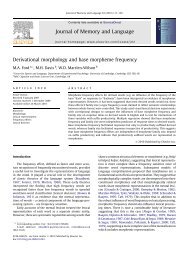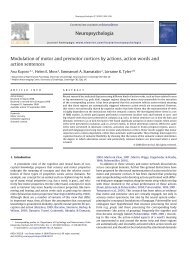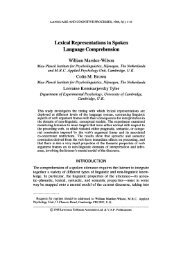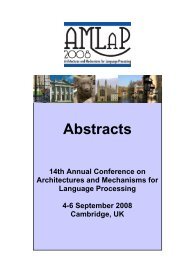Towards a psychological basis for a theory of anaphora - Centre for ...
Towards a psychological basis for a theory of anaphora - Centre for ...
Towards a psychological basis for a theory of anaphora - Centre for ...
Create successful ePaper yourself
Turn your PDF publications into a flip-book with our unique Google optimized e-Paper software.
"the butterflies" could equally well have been<br />
pronominalised. What the experiment appears to reflect<br />
instead is a second type <strong>of</strong> difficulty <strong>for</strong> young<br />
children - namely, in exploiting the in<strong>for</strong>mation carried<br />
by the lexical proper ties <strong>of</strong> an anaphor ic pronoun.<br />
Karmil<strong>of</strong>i-Smith (1979) has reported related effects in<br />
an experiment on story comprehension in children aged<br />
between four and ten years. She used, <strong>for</strong> example, a<br />
story about a child who took the only apple from a bowl<br />
<strong>of</strong> fruit. In this story the in<strong>for</strong>mation that there was<br />
just one apple was carried solely by the (lexical)<br />
contrast between the definite and the indefinite<br />
article. Up until the age <strong>of</strong> about eight, the children<br />
typically failed to draw the proper implications from<br />
this lexical cue. When asked, at the end <strong>of</strong> the story,'<br />
how many apples were left in the bowl, they would tend<br />
to reply that there were several. They justified this<br />
claim on the <strong>basis</strong> <strong>of</strong> their knowledge <strong>of</strong> normal<br />
situations in the world - bowls <strong>of</strong> fruit usually have<br />
lots <strong>of</strong> apples in them, and so on. Since these were<br />
children who could correctly interpret a definite<br />
article when heard in an isolated sentence ,<br />
Karmil<strong>of</strong>f-Smith<br />
argues that their failure to do so in a<br />
story context reflects the dominance oE pragmatic<br />
variables in their interpretation <strong>of</strong> a story.<br />
These two areas <strong>of</strong> difficulty - with the lexical<br />
and the configurational properties <strong>of</strong> pronoun anaphors -<br />
suggest that, <strong>for</strong> the five year old, the presence <strong>of</strong> a<br />
pronoun in an utterance may do little mare than to<br />
indicate that something or someone that has already been<br />
mentioned will now be talked about again. Determining<br />
exactly what is now being talked about will then depend<br />
on pragmatic inferences based on what is sald elsewhere<br />
in kho ntr ln~j. CC 1;11Itl viow <strong>of</strong> l cl~vt,lop~nonI;nL<br />
sequence is correct, than It in cartnlnly cenal~tont<br />
~ l t h an emphasis on the dominant rolo <strong>of</strong> prnq~natic<br />
It1 Crr ra11r:e 11r a Itrl:d rpta (,nLfol\ u C nr\nplru wu, 'i't r a<br />
additional discaursa processing skills that doveliap<br />
later in childhood shsu3d Iher~<strong>for</strong>e be seen ss a aort <strong>of</strong><br />
overlay an a primary process that operates in terms <strong>of</strong><br />
the plausibility <strong>of</strong> antecedent assignments in a given<br />
discourse context.<br />
4.3. The third experiment [g] represents an attempt<br />
to track the precise time-course <strong>of</strong> the mapping<br />
processes involved in the resolution <strong>of</strong> an anaphoric<br />
pronoun. We were hoping to pinpoint the particular<br />
instant at which, as it were, an anaphoric pronoun homed<br />
in on its antecedent. In the light <strong>of</strong> the other<br />
experiments we have described, and <strong>of</strong> the results we<br />
w i l l now present, this enterprise was based on too<br />
simple a conception <strong>of</strong> the anaphor resolution process.






